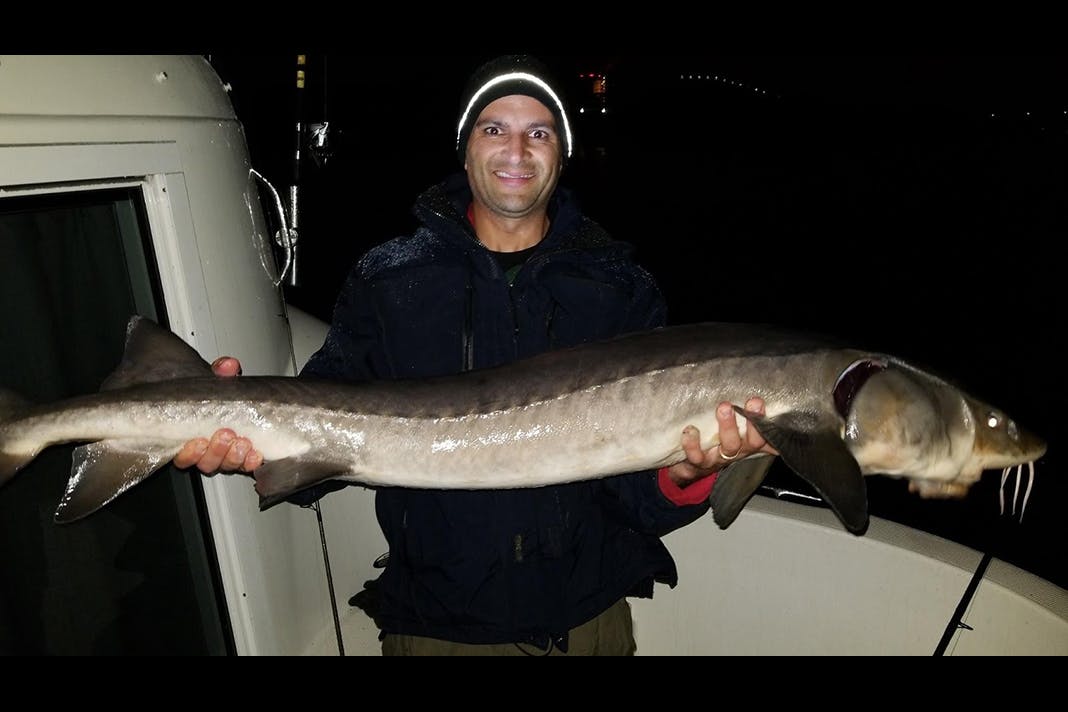
Sturgeon Fishing on the St. Croix: What you need to know to catch a living dinosaur
Sturgeon have been roaming waterways of Great Lakes Basin since the height of the dinosaurs; a scant 136 million years ago. An giant Asteroid crashing into Earth couldn’t wipe them out but humans almost did in the late 1800’s and early 1900’s through wanton waste, commercial harvest, and habitat degradation. Sturgeon were eliminated from many of their native waters. Humans slowly wisened up during the later part of the 1900’s, habitats were slowly restored, commercial fisheries shut down, and conservative recreational harvest regulations implemented. Today, Sturgeon populations have strongly rebounded in their native range, especially the St. Croix River and has quickly grown into a popular catch and release fishery.
The population in the Lower St. Croix River today is believed to be over 5,000 juvenile and adult fish, although that estimate seems low to me given how many fish I see caught and released in just a small area around the area of Bayport MN, my hometown. But then again, the sturgeon around here do not tend to be quick learners and there have been many instances of the same fish being caught multiple times (as indicated from DNR tagging studies). For the sake of my angling success, I hope they don’t wisen up anytime soon!
So let’s get to the topic at hand. Maybe you’ve seen pictures and videos from your social media network of friends reeling or holding these huge gnarly (beautiful) looking creatures that they’ve been catching all fall and you’re wondering: “Dang, how do I get into this action?” Well, I will tell you how. And this is the best thing: it’s not hard or expensive! What I describe below is based on my experiences on the St. Croix River in Minnesota. However, equipment needs and tactics described here could also be applied to other upper Midwestern waterbodies and rivers where sturgeon roam.
What do I need?
If you talk with most Sturgeon anglers, they’re likely to admit they chase flathead catfish during the summer months and use mostly the same gear. I recommend a quality reel and saving your money in other areas of your set up. You’ll need a heavy rod, a nice reel, some heavy braid line, and a couple dollars’ worth of slides, weights, and hooks.
Rod:
Most of the time the rod will be sitting in a rod holder, so issues like weight and sensitivity are less of an issue than if you were casting or jigging. If you are on a budget, you can save some dough on the rod and go with a 7’0 to 7’6 Medium Heavy stout fiberglass rod. Although heavier than graphite, fiberglass rods are cheaper, and are typically stronger and more durable than graphite rods. Still, I don’t frown on any high-quality graphite Musky rod if you already chase those or may have a future interest. Baitcaster or Spinning rods will work depending on preference. If you are fishing from shore, try a long surf rod with a large capacity spinning reel so you can chuck your rig a mile into the channel.
Reel:
Spinning or Baitcaster? To be honest, I don’t think it matters much and it is a matter of preference. I could go either way. The sweet tinking sound of the drag from a large spinning reel as a hooked-up tank sturgeon goes where she pleases while you struggle in awe is tough to beat. But sometimes, I prefer security of a baitcaster winch on a crane-like rod Get 1 (or 2) of both. Get at least a 6500-sized reel but ideally up to a 7500. Here’s 2 reel options that will work for sturgeon fishing:
Daiwa Line Counter with Spool Click
Again, the goal is a powerful winch, not a smooth casting ergonomic featherlight thing. Give me big gears, big drag, big handle, lots of spool capacity. You won’t need a baitclicker for sturgeon (more on this later) but I would look for the feature anyway assuming that you’d want to have the versatility for fishing for other species like flathead catfish. For a spinning reel, also, the bigger the better. You’ll want a reel that can hold at least 100 yards of 65 lb braid.
Line:
Also a matter of preference, but I’ve had good luck with 65-80 lb braid. If you have the spool capacity, go the biggest you can. Sturgeon are basically blind. You could be fishing with dock line and sturgeon still wouldn’t see it. The reason for the heavy line is three-fold. First, the pull on these fish is probably twice as any other fish; Second, they do actually get to 65-80 lbs; Third, smaller sturgeon have a tendency to wrap themselves around the line and have spine-like plates near their belly called scutes that can cut line quite easily. A 80 lb braid is usually tough enough to withstand that abrasion. I also like the zero stretch of a braid for bite detection which can be subtle.
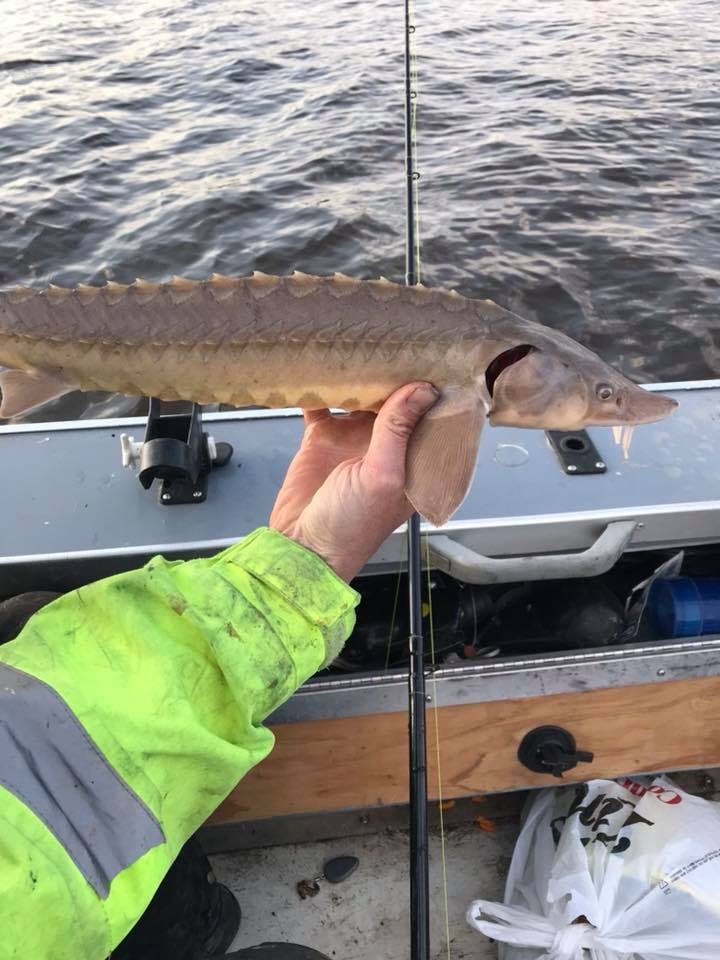
Courtesy of Jeremy Tueffel via MN Sturgeon Fishing Facebook group.
Rig:
You want your bait on bottom and line taught, so use the smallest slide sinker that will accomplish that objective. In the slack current of the St. Croix near the Bayport area, I’ve found 2oz to 4oz to be the right weight, with 3oz being my Goldilocks. I use a sinker slide with a clip above a large double barrel swivel. That way, I can change out sinker depending on the condition (or take them off when in transport) without having to re-rig. These sinker slides are the best $3 you’ll spend on your rig. You can also use an inline weight that lets the line pass through it. Connected to the other end of my swivel is a 12” to 18” braid leader tied up to a 8/0 heavy duty circle hook. You’ll need a fairly big hook to hold the ball of meat your hucking out there. I prefer a circle hook to traditional offset, octopus, or baitholder hooks because they set themselves and you may get a sturgeon to set the hook on itself before you even notice the tip dancing in the rod holder.
Sturgeon have large fleshy, tube-like mouths that vacuum up all the dead gizzard shad on the river bottom. Also, much like a vacuum, when they are on, they don’t discriminate and will suck up cut suckers, whole dead suckers, crawlers, fathead minnows and other creative concoctions. I am typically biased toward big hooks and big bait, but I’ve heard plenty of stories of large fish being caught off smaller hooks with only a nibble of crawler on it. Be that as it may, going with the downsized strategy means greater harassment by bait robbing freshwater drum (sheepshead) and the legendary half salamander half fish freak of nature called a mudpuppy. That’s why I go big or go home. Finally, get yourself some clip on lights and bells from Amazon - http://a.co/d/3XQxjTJ so you can easily detect bites at night. You can catch sturgeon all hours of the day but catch rates do seem to be higher in the eve into the night than in the day and the wind has a tendency to die down. Plus, most of the Al Czervik’s (Rodney Dangerfield in “Caddyshack”) of the world will have their yacht’s docked at the local Yacht Club by dark so a guy/gal in a 16’ fishing boat can have some peace and not worry about being swamped by the ginormous wakes those things throw at little more than idle.
So for equipment, that’s really all you need to get started. You may tweak the hook size here, or leader length there, or maybe try different weight sizes/shapes...but this is the rig up you’ll see on most sturgeon boats on the St. Croix on a fall evening. Now that you have your gear, what to do next? Where to go? What depths? What kind of habitats should you look for?
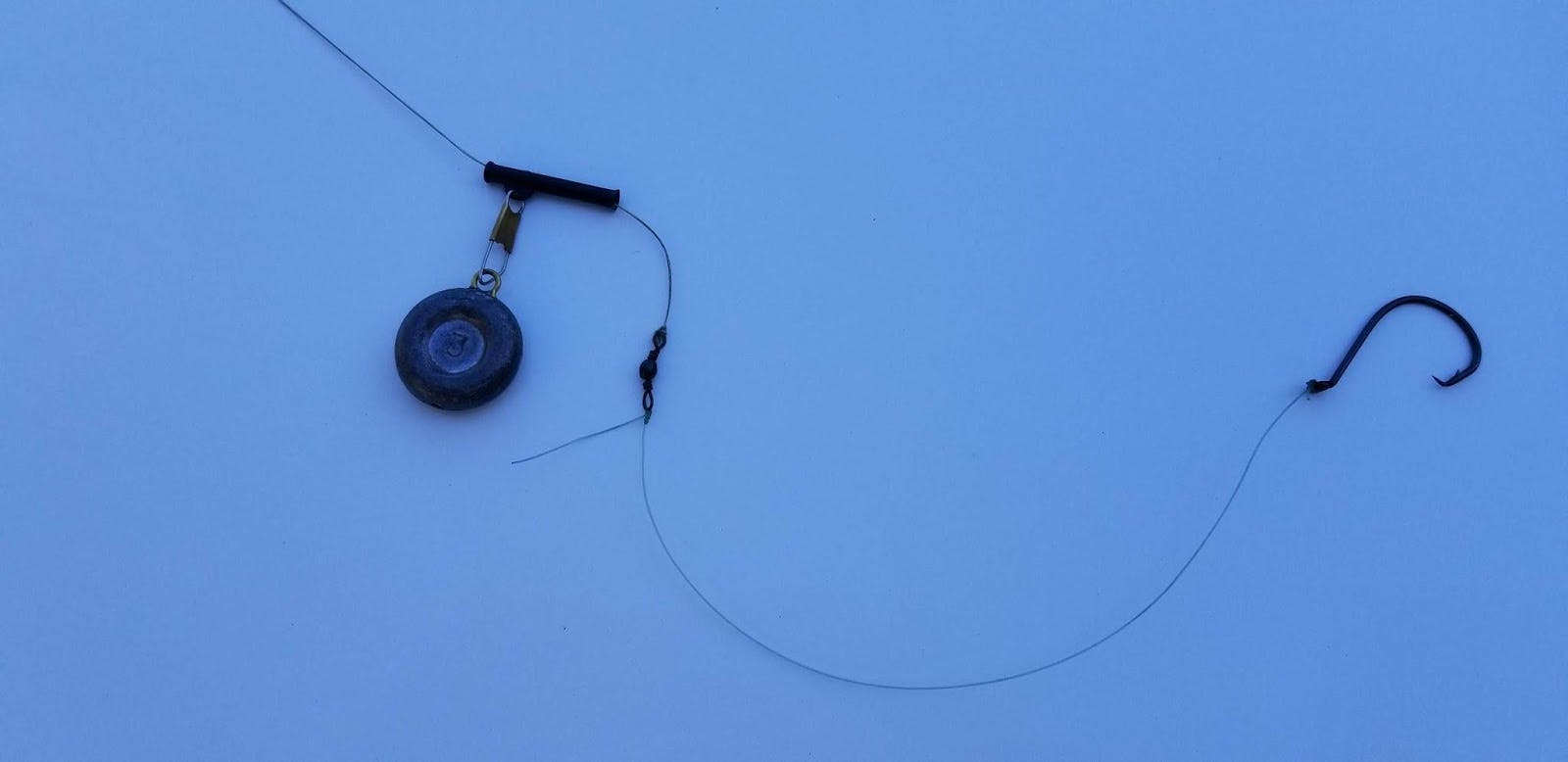
Tactics:
Where to fish:
Sturgeon on the St. Croix during the late summer, fall, and winter seem to roam and forage flat featureless bottoms in 20-45 feet of water. For any other fish species I fish, I pour over contour maps and look habitat edges, humps, holes, or points that may be attracting the fish I am pursuing, and most of the time, the efforts to find those spot-on-a-spot habitats pays off. Every conventional tool I’ve used for other fish just doesn’t seem to make any difference when it comes to Sturgeon. You can play eenie-meenie-miney-moe on the contour map and that random spot in the channel you pick will probably be as productive as anywhere else. This is a good thing for beginners but frustrating for more seasoned anglers who are looking for an edge. So, pick a random spot in the middle of the channel and give it a try. If you see a flotilla of other boats bunching together, it’s not likely they know anything you don’t. Find your own spot where you have some room, bait up and cast, put your rod in the holder, crack a cold one and toast with whomever has the pleasure of sharing the boat with you that eve and relax.
Bait:
As mentioned earlier, sturgeon seem to function as biological vacuums using their uniquely adapted mouth to suck up anything edible on bottom. The fisheries science texts will tell you they eat invertebrates (larval insects) and mollusks (mussels), but not much has been confirmed by Fisheries studies on the St. Croix River. In the St. Croix River, gizzard shad dominate the forage biomass in the river and their populations turnover constantly.
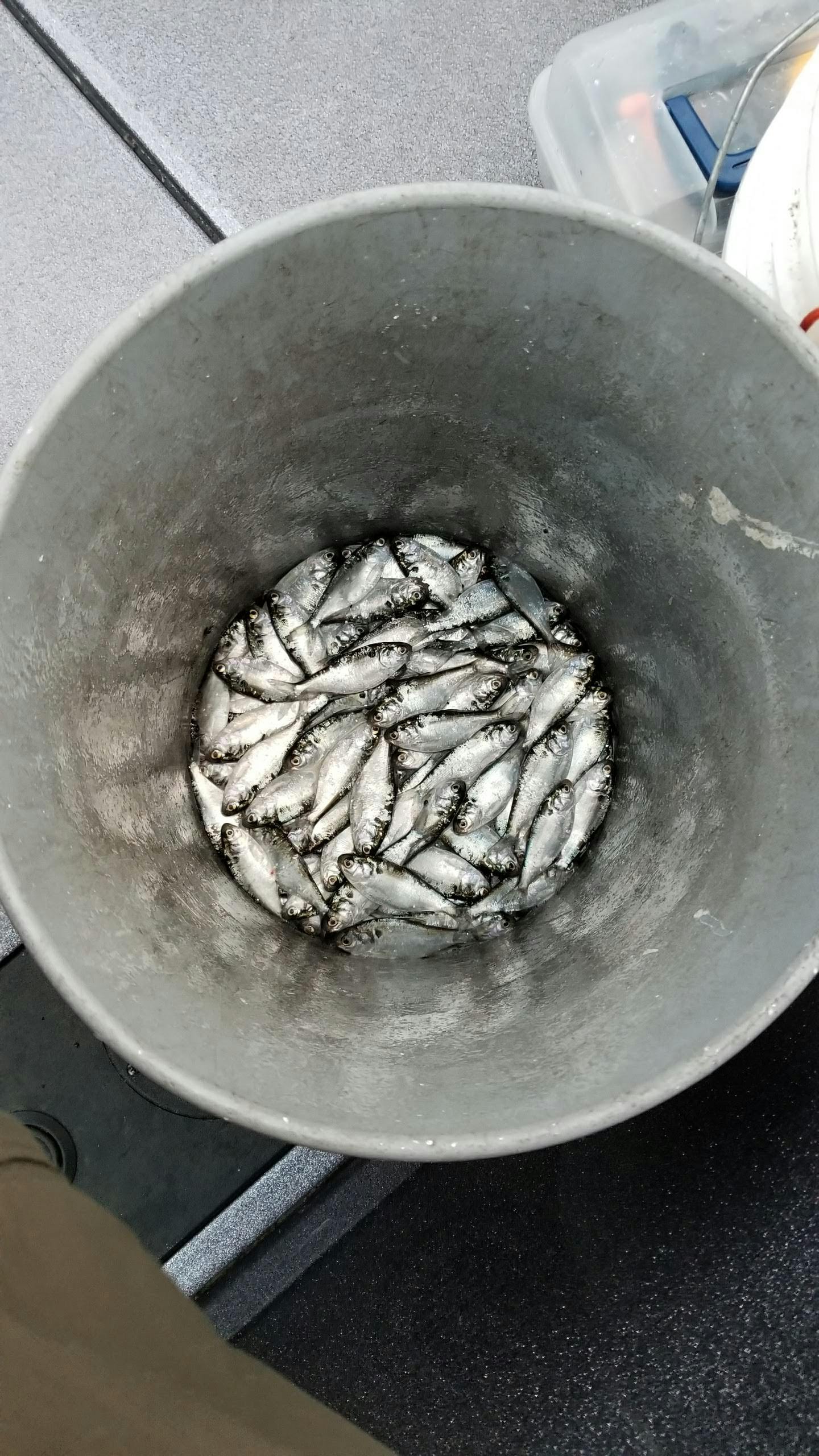
Gizzard shad caught with a cast-net by the author on the St. Croix River.
I speculate gizzard shad carcasses litter the bottom and provide a nutritious food source for St. Croix sturgeon. Indeed, fresh dead gizzard shad are arguably the best bait you can use for Sturgeon. The difficulty with using Shad is navigating the complicated regulations surrounding their capture and use for bait, finding a reliable source and provided you have the appropriate netting permit(s) successfully netting them. Don’t expect success with anything less than fresh shad or other cut bait like suckers. Apparently, Sturgeon have discerning taste buds and must not like the freezer burn or the “fishy” taste of fish that’s been frozen. 2-3 nightcrawlers wrapped up on a hook and/or 3 fathead minnows are also must have’s on your boat’s sturgeon smorgass board. Worms like to wrap themselves up and twist up your line. So check your worm rod often. If someone has a technique for dealing with this issue, I’d be interested to hear.
Bite Detection and Hook Up:
One of the biggest mistakes over-confident Cat anglers make when assuming they can transfer their fishing tactics to sturgeon is thinking that a sturgeon will take the bait like a flathead catfish. Cast your bait, tighten up the slack, turn on the bait clicker, open the bail and wait for the “click-click-click” as the fish swims away with the bait in its mouth. Sturgeon generally don’t take the bait and start swimming away. Rather, they’ll hover over your bait, suck it up and chew on it for a while and decide whether they like it or not. If you have your line nice and taught, this action is manifested by a dancing tip. If that tip is fluttering, you have a fish on and you need to respond immediately. Waiting will usually result in the fish finally feeling something it doesn’t like and it spitting it out. So don’t wait to set the hook!
Setting the hook:
If you are using a circle hook, then you don’t want to lay into it like a bass. Rather, circle hooks will set themselves as tension is put on the line. As such, when that tipe starts to dance, open the bail so you can get the rod out of the holder, close it, and then start reeling down quickly until you feel the rod load up. Then hold on...it’s on! Now, chances are it’ll be a dink but you’ll know right away. They come up with ease and for some odd reason they like to barrel roll on your line and wrap themselves up. Fish over 45” don’t seem to do this and they are MUCH stronger (see video). I caution giving the rod with a large fish on to any child less than 12 because they will simply be too much for them. Chances are they’ll just let the rod go once the fish decides she’s going for it.
When to fish:
Although the Sturgeon opener is in June in Minnesota, the fishing is pretty slow until the water starts to cool.
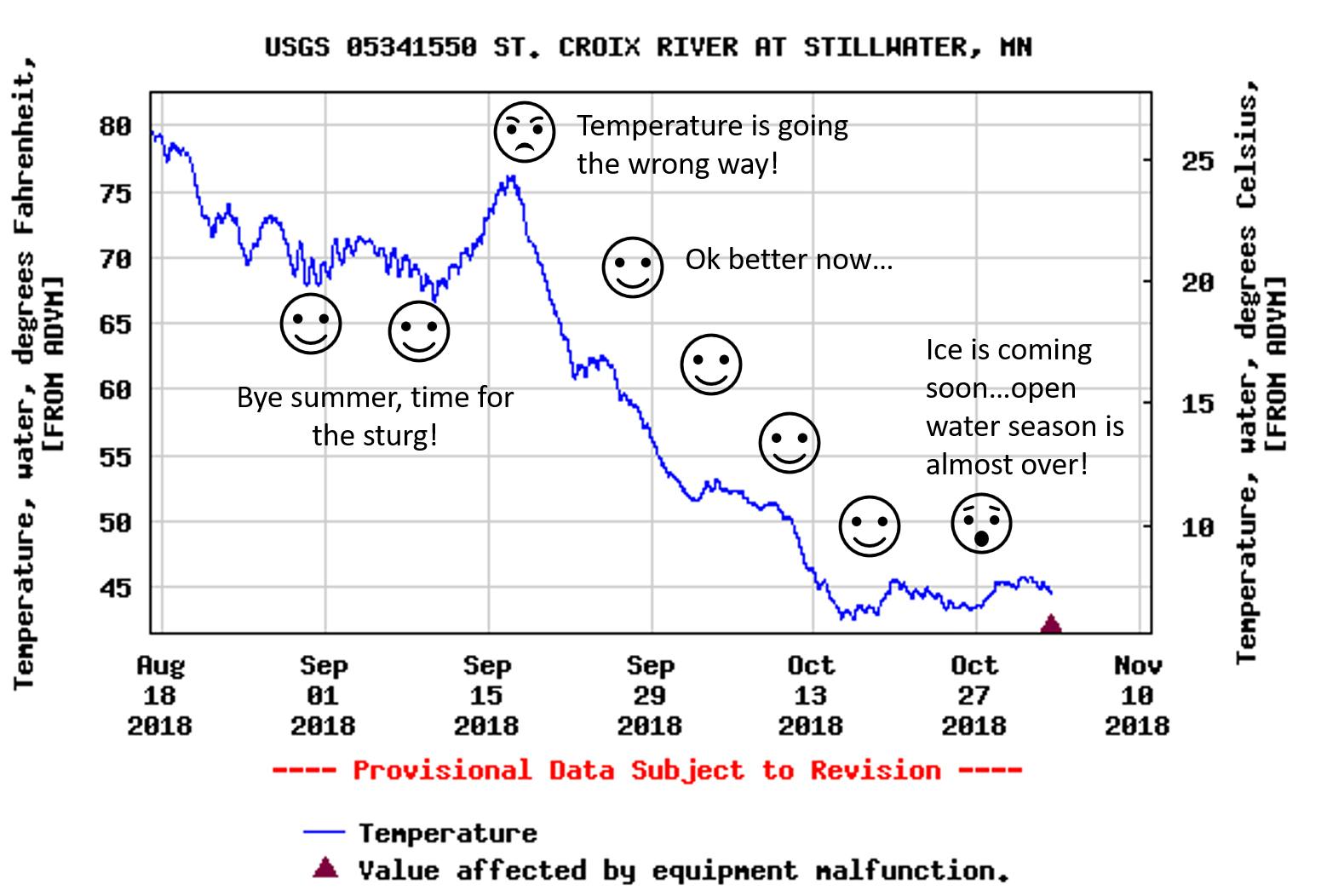
Current and historic water temperature and elevation data is available from the USGS for Stillwater. I’ll also use the Advanced Hydrologic Prediction service from the National Weather Service to monitor water elevations and flood forecasts on the river. Sturgeon fishing starts to heat up as the water cools down. When the temperature falls below 70 degrees, that’s usually my trigger to start clearing my schedule (as much as my schedule allows) and get out on the water as much as possible until the river locks up with ice. I’ve heard stories of guys venturing out with ice skimming the surface and returning later that eve to ice thick enough that hulls and lower units were damaged. No fish is worth destroying your boat.
Fish remain active feeding through winter, so after the boat is put away and you get 4” of ice built up, you can continue the fun through the ice (a subject of a future post).
Once the ice breaks up in spring, Sturgeon are less in the mood for food, and more in the mood for love and they start heading upstream and into shallow tributaries to spawn. Sturgeon seem to disappear from angler’s creels during the summer aside from a few here and there.
Despite putting on the feed bag in fall, sturgeon are one of the slowest growing fish of which I am aware. I caught a tagged 42” fish in October 2018. I reported it to the DNR and they informed me that fish was reported by another angler around the same time and place 7 years earlier and was 40.” Two inches in 7 years! The fish was originally caught and tagged in 2007 3.5 miles downstream from where I caught it and it was 30.5.” Other published data support that Sturgeon generally grow at a modest pace until they hit maturity. Fish mature anywhere between 15 and 25 years old and 45-55” in length. Once fish mature, reproduction takes most of their energy and very little remains for growth. So anytime you catch a 55-65” fish, that fish might be 80, maybe even 100 years old! That’s pretty amazing and you don’t need to have a master’s degree in Fisheries Biology to understand how vulnerable these populations are to even small amounts of harvest. I hope catch and release regulations remain intact in Minnesota far into the future!
So there you have it. There’s not many other opportunities to catch such a unique and large fish with such little investment. Omnia Fishing can get you set up with the gear, you just have to find the time. Enjoy.





